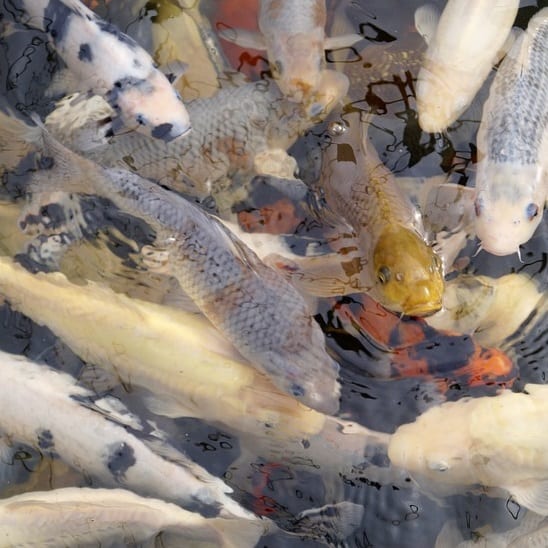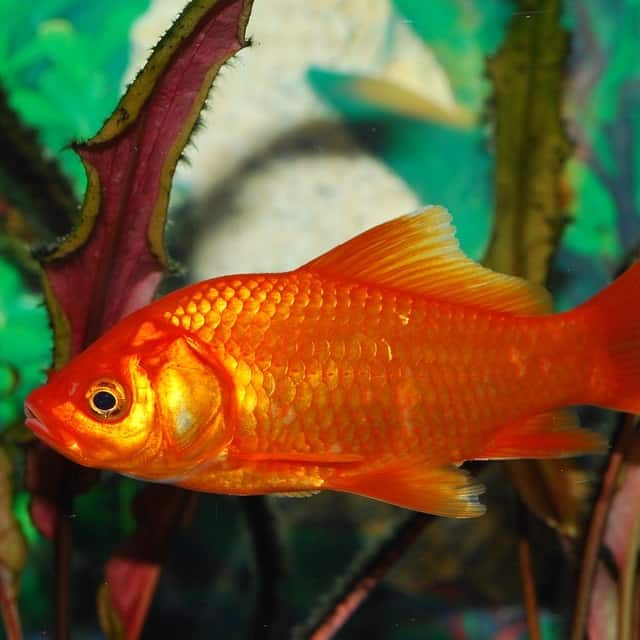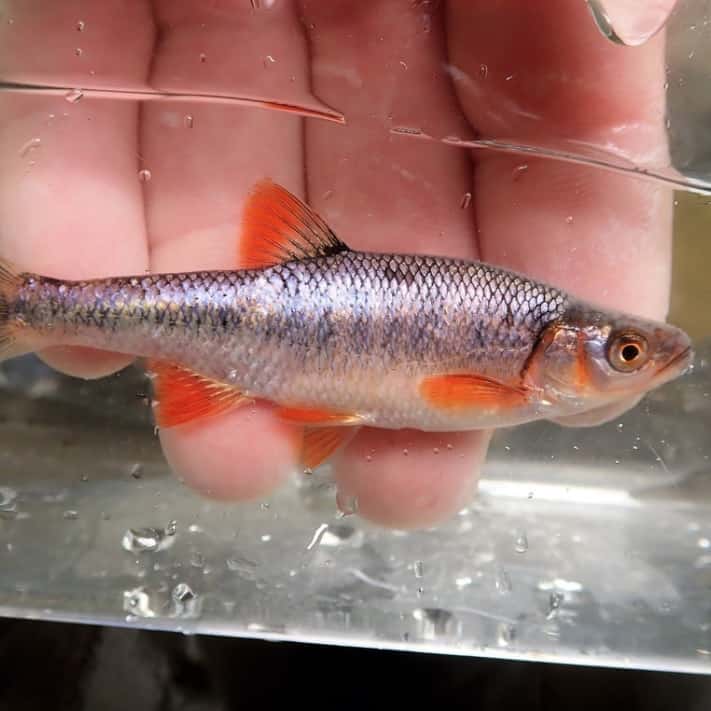How to Feed Koi Fish in the Winter Updated
How to Feed Koi Fish in the Winter
Types of Freshwater Swimming Fish That Tin can Alive In Outdoor Ponds 2022

Depending on where y'all live, at that place's a pretty large diverseness of fish that tin can exist kept in outdoor ponds. Y'all'll have to be aware, of course, of their hardiness and whether or not they will be able to overwinter based on the climate that you live in. This is 1 reason of many why it's critical that you inquiry fish species to ensure the wellness of both your fish and your swimming. In add-on, some fish may become along well with others, and other species may be confrontational or simply enjoy eating fish that are smaller than them.
Another thing to keep in heed is that all fish take different requirements, then you'll need to be sure that first, the fish you want can actually survive in an outdoor pond, and second, will be able to handle any conditions y'all have (water temperature, pH levels, ambient air temperature, nutrient levels, etc.). Below you'll find a wide list of fish for only nigh any outdoor pond.
Bestseller No. 1
Hikari Usa Inc 02370 Gilded 4.4 Lb, Medium
- Hikari Gilded four.4 Lb Medium
- Hikari Aureate is a daily nutrition, adult through years of koi breeding and showing, to meet the nutritional needs of koi
- Provides excellent colour enhancement.
Listing of the Best Pond Fish You Tin Keep In Garden Ponds (Big & Small)
1) Common Goldfish (Carassius auratus)

Originally domesticated from the Asian bother in China over 1,000 years ago, goldfish vary somewhat in coloration and a fair amount in size depending on the species – some may merely grow to a couple inches long by adulthood, while other species can grow up to a foot. This means yous can easily cull whichever species best suits the size of your swimming. They're generally pretty amiable, getting forth with just about anything in the pond, but that doesn't mean everything will become along with them – the smaller varieties are decumbent to being eaten by some fish, such as golden orfes (if the goldfish are a couple inches or less in size). Goldfish do best in a temperature range of 68 to 72 degrees Fahrenheit (20 to 22° C) and a pH range of vii.ii to 7.half-dozen.
While regular "feeder" goldfish (the variety covered in a higher place) tend to be energetic, fast, and enjoy swimming about, fancy goldfish are typically tedious, and can't actually compete with other fish for food. For this reason, regular goldfish and fancy goldfish should non be kept together, nor should fancy goldfish be kept with really any fish multifariousness that's more than rambunctious and eats the same food equally fancy goldfish.
Fancies come up in many varieties, and are oftentimes sought out for their varied, unique appearances that can really add together a distinct, exotic flair to any pond. Most fancies practice well with a temperature range of 68 to 74° F (20 to 23° C), though at that place are many dissimilar types that accept slightly different requirements. Fantails (which have a forked caudal fin), for example, are healthiest in temps between 70 and lxxx° F (21 and 26° C), while lionheads are best adapted to temperatures as depression equally 65° F (eighteen° C). In addition, they each have different temperaments, so farther research will exist needed before yous cull a diversity. About tin exist kept in outdoor ponds so long every bit their temperature and pH requirements are met, merely may need to exist brought indoors for wintertime if ambient air and water temperatures drop too low.
One of the nigh popular pond fish species, and understandably so, koi are typically a maximum of a foot to three feet in size depending on the exact variety and accept a stunning amount diversity in their coloration and patterning. At that place are over 100 different recognized koi subspecies inside 13 official classes, meaning there's a koi out there for just about anyone. They're fairly tolerant of temperature shifts so long as they don't happen too speedily, as with any fish this can crusade stress, shock, or fifty-fifty death. A water temperature between 59-77° F (15 to 25° C) – which makes them pretty well suited to life in outdoor ponds – and a pH range of 7.5 to viii works best to go on them strong and healthy. You'll demand to have a larger pond, at least a meter deep, if you program on having whatever of these fish in your pond.
Orfes, also known as ides or golden orfes, typically abound around a foot to a foot and a half in length in ponds (they need to be at least 1,000 gallons and a meter or more than in depth), though in larger ponds and lakes with plenty of nutrient availability they can grow shut to iii anxiety. Golden orfes are extremely sensitive to h2o quality issues; in fact, many areas use the "golden orfe toxicity test" to decide water quality. If it's not good plenty for an orfe, the h2o is deemed unhealthy and in need of handling. In terms of temperature, orfes are extremely hardy, making them ideal for outdoor ponds – they can tolerate water temperatures as low every bit freezing or as high every bit xc° F (32° C), but practice best between 50 and 77° F (10 to 25° C), with a pH on the more alkali metal side, between 7 and 8.
One of the most important things to continue in mind with orfes is that they're uncommonly agile. This makes them prone to oxygen deprivation, and so you'll need to brand sure oxygen levels are high in your pond (a minimum of 7-8 ppm). Information technology too means that they're prone to jumping out of ponds, then having boundaries in place to preclude this is important – specially since in many areas they're considered an invasive species and should never exist let out of captivity.
To being, pond sturgeons are large – even the smallest multifariousness, the sterlet sturgeon, grows to a meter, while the largest, the beluga sturgeon, can grow up to 10 meters in length and several thousand pounds in weight. Do not keep a sturgeon if you don't a have a large pond or a lake. Sturgeons began to evolve almost 250 one thousand thousand years ago, and as such are incredibly resilient (subsequently all, they're living dinosaurs!). While their temperature range depends on the exact species, generally so long as you lot keep the temperature higher up freezing and below seventy° F (22° C), they should do fine (just of grade exercise further research on the requirements of the item sturgeon species you'd like!). They prefer darkness, as in the wild they tend to stay toward the lesser of h2o bodies, and as such they'll need plenty of hiding places to protect themselves from the brightness and excess warmth of the sunday. They besides require a high quality sturgeon feed with upwards of 40% crude protein by weight for the best possible growth and wellness.
Plecos, which are infrequent algae-eaters that are easygoing and peaceful fish, getting along well with other fish species, are warm-h2o fish. As such, they need water temperatures that range from 72 to 86° F (22 to xxx° C). Mutual plecos can exist 1 to two feet long, while bristlenose plecos are only about 4 inches, so pond size requirements depends on the species that you choose. They exercise well in outdoor ponds, with 1 exception – they're originally from Due south America, so if your water temperature drops below 50° F for more than a day or two, they'll need to be brought indoors or they will likely die.
Siamese algae eaters are, as their proper noun implies, excellent at consuming algae (which makes them particularly desirable to many pond hobbyists). They're besides pretty lively, and as such shouldn't be placed with more docile fish species (such as fancy goldfish), as they may stress them out with their spirited nature. They typically grow up to half dozen inches in length, and exercise best in waters that are 70 to 79° F (21 to 26° C), needing to exist brought indoors if temperatures driblet much below this for extended periods of time, such as during winter.
8) Weather Loach (Misgurnus anguillicaudatus)

Weather loaches, likewise known as pond loaches, are quite tolerant of temperature shifts, able to withstand water temperatures anywhere from twoscore to 77° F (four.5-25° C), significant that they can generally stay in outdoor ponds even during the winter without any issues. You'll desire to get more than one of them, as they're adequately social and enjoy staying in pocket-size groups with their own kind. In improver, they abound up to a foot and aren't picky eaters, consuming algae, insects, vegetables, and food pellets without complaint.
Though often kept in aquariums, mollies and guppies tin both do well in outdoor ponds. Both species volition likely demand to be brought indoors for wintertime, as mollies need waters above 75°F and guppies demand waters above fifty° F. They're both like shooting fish in a barrel and straightforward to accept care of, though they breed quickly – you'll likely demand to catch some of them every so often and sell them to a local pet store (never release them into the wild!). They could also be used as a food source if you have a separate pond for turtles and frogs and the like.
10) Cherry-red Shiners (Cyprinella lutrensis)

Red shiners are a North American pocket-size freshwater fish with silver bodies (sometimes vibrant blueish) and ruby-red-orange fins. They're pretty pocket-size (most three inches in length), and are a cold water fish, preferring temperatures between 59 and 77° F (fifteen-25° C). However, since they are often found in mountainous regions, they are able to withstand extreme temperatures (as low as -21° C), though this is of course non at all brash and they will need to be brought indoors for the winter if waters drop below their judge healthy minimum of 59° F.
They're a generalist species, well-suited to living but virtually anywhere, from cold mountain rivers to southern hot springs. In addition, in many areas they are considered invasive, both in portions of the U.S. and the U.G., and then never release them into the wild or utilise them as allurement for fishing in natural areas. Because of their rapid reproduction, they quickly become a problem species in the wild and cause all sorts of ecological damage.
xi) High-Fin Banded Shark (Myxocyprinus asiaticus)

Also known equally the batfish due to its dark, nigh bat-like advent, the Chinese high fin banded shark is a suckering algae eater. They're very peaceful and low-key, compatible with merely virtually any other fish, including koi, goldfish, guppies, and plecos. They are happiest when living in minor schools of 3 or more of their own, but volition do alright on their own as well, and demand cool waters (with plenty of hiding places) betwixt 55-75° F (13-24° C). This means that they tin stay in outdoor ponds even during the winter, so long every bit you proceed your water heated above this minimum range. Their patterning is quite hitting, and though they tin can grow up to 4 feet in length, it takes them quite a few years to reach this signal since they primarily feed on algae.
12) Pumpkinseed Fish (Lepomis gibbosus)

Pumpkinseed fish, a type of sunfish, are remarkable looking fish with bright coloration and patterning that are native to portions of Due north America. It's an invasive species throughout the majority of Europe, so never release it into the wild if y'all live in that location. Their size varies from 3 to 8 inches in length, and are very active, preferring to live in small schools so if you want one, you'll demand to get a few to ensure their happiness. They're tolerant of a range of conditions (with the exception of overall water quality, equally is the example with most pond fish), but ideal water temperature for them is between 69 and 75° F (21 to 24° C), with an alkaline pH between 7 and 7.5. They work well in both large and small ponds, and are capable of overwinter then long as yous keep your pond heated.
How to Feed Koi Fish in the Winter
Posted by: geraldphey1939.blogspot.com

0 Response to "How to Feed Koi Fish in the Winter Updated"
Post a Comment